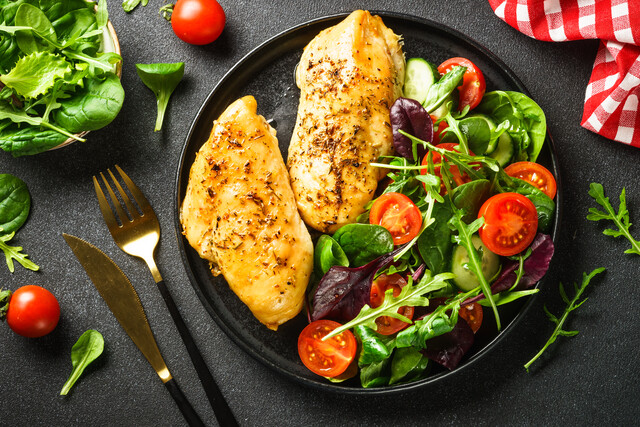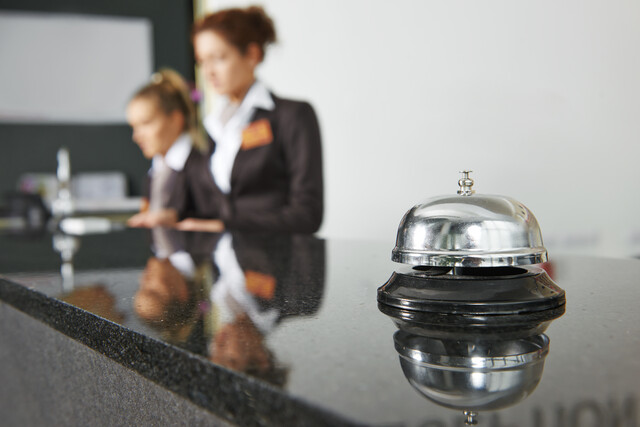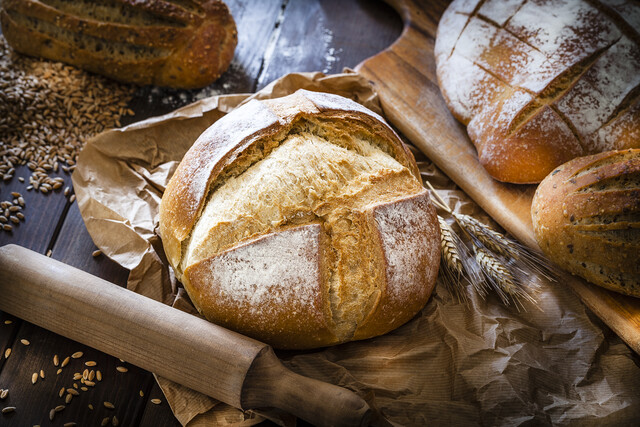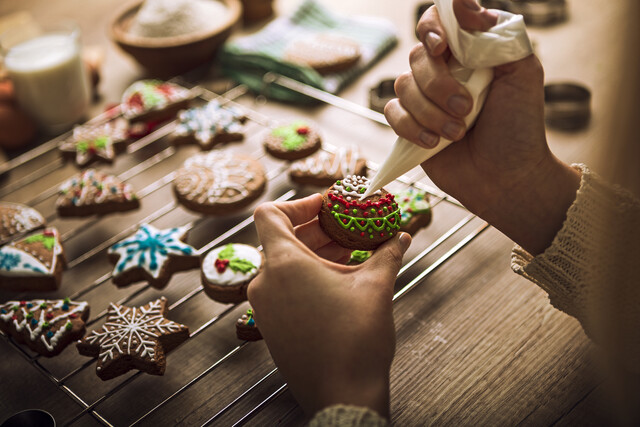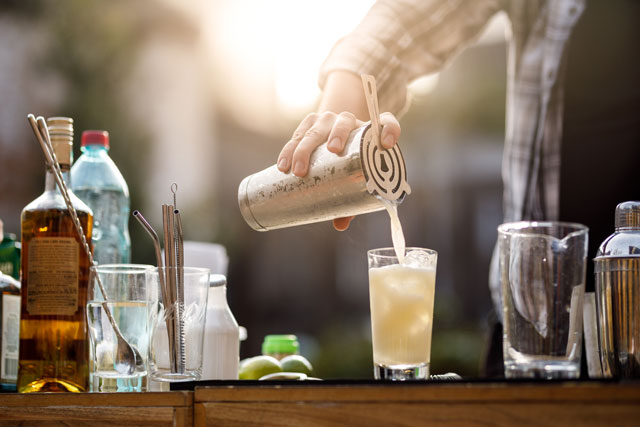Note: There are two ways to calibrate a thermometer -- the ice point method and the boiling point method.
- Ice point method: Fill a small container (cup-sized) with ice and add water. Allow the ice water mix about two minutes to reach a stable temperature throughout, and then insert the thermometer. Hold the thermometer and make sure it stays in the middle of the cup, away from the bottom and sides of the container. The thermometer should be within 2�F of 32�F.
- Boiling point method: Heat a pan of distilled water on the stove (regular tap water has mineral deposits that can throw off the exact temperature readings). Wait until the water reaches a rolling boil, then insert the thermometer. Hold the thermometer and make sure it stays in the middle of the pan, away from the bottom and sides of the container. The thermometer should be within 2�F of 212�F. Why this works: Water in an open pot can never reach more than 212�F, because it vaporizes and turns into steam. At a rolling boil, the average temp throughout the pot will be 212�F.
- In addition to regularly calibrating thermometers, you can also use more than one thermometer in critical areas like the cooler and hot or cold food holding areas. A discrepancy between the two will provide an early warning signal that both need to be calibrated.
Cooking temps (Source: www.foodsafety.gov):
Cooking temperatures charts are readily available online from food safety organizations. Print one out, laminate it, and keep it near hot stations for handy reference.
140�F (60�C) for all foods that will be held hot prior to service.
145�F (63�C) for 15 seconds for fish; seafood; veal; lamb; mutton; pork; pork roasts and cured pork (like ham); raw shell eggs for immediate service.
155�F (68�C) for 15 seconds for ground beef, ground fish or ground meat (pork, beef); raw eggs not prepared for immediate service; and inspected game animals.
165�F (74�C) for 15 seconds for poultry; wild game, stuffed fish, stuffed meat, stuffed pasta, stuffed poultry; stuffing containing fish, meat, or poultry. Also, any dishes containing previously cooked foods.
Whole beef roasts, pork roasts, and ham are safely cooked after reaching the minimum internal temperature for the prescribed amount of time as follows:
130�F (54�C) for 121 minutes
132�F (56�C) for 77 minutes
134�F (57�C) for 47 minutes
136�F (58�C) for 23 minutes
138�F (59�C) for 19 minutes
140�F (60�C) for 12 minutes
142�F (61�C) for 8 minutes
144�F (62�C) for 5 minutes
145�F (63�C) for 3 minutes
For more information, refer to www.foodsafety.org, and keep cooking temperature requirements posted in plain sight around the cooking area.
Although it is important to cook food to the right temperature, you also have to serve it at the right temperature. Hot food has to leave the kitchen at least at 140�F. Cold food must leave the kitchen at 41�F or colder. Steam table or buffet temperatures must also be maintained constantly and verified with thermometers. Hot foods on a buffet line should not sit out for more than an hour and a half.
According to the American Egg Board, the risk of an egg being contaminated with salmonella bacteria is about 1 in 20,000 eggs. But if that one egg happens to be in your establishment, and if it is somehow improperly cooked, it could end up making several people severely ill, particularly the very young, very old, or those who are pregnant or have weakened immune systems.
From the outside, the egg seems like nature's perfectly protected package, and in a way it is. It has a hard, durable shell. During hatching, the hen coats her egg with a protective coating that helps it stay fresh and healthy. And it is made to last; in the old days, eggs would be kept at room temperature for extended periods of time and didn't spoil.
So one has to wonder, how does a germ that thrives in animal waste get inside an animal's egg? There are a few ways it can happen, and no one is really sure which route is most common. The bacteria may live in the hen's reproductive tract and get inside the egg as it is developing and before the shell hardens. Or, the germs might work their way through the tiny pores on the surface of the egg. Either way, when salmonella is present in an egg, it is usually in the yolk, but scientists think it can also thrive in the white. That is why food safety experts insist that no one should eat undercooked egg products.
There are several steps involved in keeping eggs safe.
- Only accept or use clean, uncracked eggs. Cracked shells only increase the chances of spoilage and contamination.
- Do not wash eggs after purchase. The egg production facility washes and cleans the eggs in a special way that does not remove the protective coating the hen puts on the egg. Washing them at your facility will only increase the odds of cracking the egg or speeding spoilage.
- Keep eggs refrigerated below 45�F, but do not freeze.
- Make sure that you use eggs in order of age: first in, first out.
- Don't leave eggs sitting out of the refrigerator for extended periods of time. As the cold eggs sit, condensation will form on their shells, which can provide a good environment for bacteria to grow.
- Do not separate eggs by passing them back and forth between halves of the shell.
- Always wash hands before and after handling eggs.
- Immediately wash any bowls or utensils used in preparing raw eggs.
When you have a buffet line, it is really important to keep an eye on how long egg dishes have been sitting out. Don't let hot egg dishes sit for longer than 30 minutes. When replenishing egg dishes on a buffet, throw away any leftover eggs that have been sitting. Don't mix them into the fresh tray of eggs.
Eggs should be cooked until the white is completely set and the yolk is beginning to thicken. Scrambled eggs must be cooked until set all the way through -- not runny. And all egg dishes should be cooked to a minimum internal temperature of 160�F.
The major problem germ in beef is E. coli. Occasionally, during the slaughter process, the exterior surface of meats become contaminated with fecal matter. If that material contains E. coli, and the meat is not handled properly, the contamination can spread. The more meat is chopped, ground, and mixed together, the greater the odds of contamination. For that reason, ground beef is more prone to E. coli contamination than steaks. Add to that the fact that the outside of a hamburger patty gets a lot hotter than the inside, and you have a nice, warm, fat- and protein-rich breeding ground for E. coli germs.
Basic steps to protect against E. coli:
- Wash your hands before touching beef.
- Store beef between 28� and 32�F.
- Never let meat defrost at room temperature -- allow ample time for it to thaw in the refrigerator (15 to 24 hours).
- Store raw meats on the lowest shelf of the refrigerator, and where they can't drip onto ready-to-eat foods.
- Use separate cutting boards for cooked meats, raw meats, and vegetables.
- Cook all hamburgers to an internal temperature of 155�F.
- Carefully monitor the temperature of foods on buffet tables.
- Wash, rinse, and sanitize all utensils and cutting boards between uses.
- Do not touch food if you think you are currently sick with the E. coli virus.
Chicken is now America's favorite protein, according to the United States Department of Agriculture. Once a less-favored product, chicken had the advantage of a relatively low fat content and a low cost, which eventually improved its standing among American consumers. The downside to the bird, however, is that it can play host to a range of bacteria, including salmonella, staphylococcus aureus, campylobacter jejuni, and listeria.
For a couple of years, it almost seemed as if poultry-phobia had gripped the nation. There was talk of washing birds, washing everything in the same room with the bird, and sterilizing counters in the same kitchen with the bird. Perhaps we exaggerate. But the fact is that chicken and other poultry got a lot of bad press. In reality, modern chicken processing is very clean and safe, and the animals are inspected several times for any sign of disease. However, the germs these animals can carry aren't always visible or smell-able. Chickens also tend to leak when you open their packaging, which provides an easy way for germs to move from one surface to another. Poultry does not have to be washed before cooking: Rinsing can actually increase the chances of cross-contamination and it isn't even necessary, because high cooking temps will kill any bacteria on the outer surface of the bird.
However, it is important to thoroughly clean anything that comes in contact with a raw bird, including utensils, counter tops, plates, prep surfaces, and sinks.
Careful attention to your birds will keep them safe and healthy.
- Always wash hands before handling poultry.
- Never let poultry defrost at room temperature -- allow ample time for it to thaw in the refrigerator (one to two days for a whole bird).
- Store raw poultry on the lowest shelf of the refrigerator, and where juices can't drip onto ready-to-eat foods.
- Use separate cutting boards for cooked poultry, raw poultry, and vegetables.
-
Use a meat thermometer to judge doneness.
-
Boneless chicken should be cooked to 165�F
-
Bone-in chicken parts should be cooked to 170�F.
-
Whole chickens should be cooked to 180�F (thermometer inserted at the thigh).
-
Reheated chicken leftovers should be cooked to 165�F.
-
Whole cooked turkeys should be cooked to 165�F.
- Carefully monitor the temperature of foods on buffet tables.
- Wash, rinse and sanitize all utensils and cutting boards between uses.
- Never use a marinade in which raw poultry was soaking as a sauce unless you boil it thoroughly first.
Most restaurants do not can or preserve their own food, but they do use a lot of canned items. So what happens when you find a dented can? Food is expensive, especially the super-sized cans of food used in commercial kitchens. When you see a slightly dented can, the temptation can be great to go ahead and use it. After all, the odds or good that someone just set it down too hard or dropped it on the floor, causing a minor dent. What harm could it do?
Well, it could make someone very sick. If a can gets dented near the seam, it could break the vacuum seal, which would allow air and bacteria to get inside the food and start multiplying. Once the can is dented, you have no way of knowing how long ago the damage happened, or how long the bacteria may have been growing. You might think that cooking the food will kill all the germs inside the can, but that isn't always true. Botulism, a deadly disease, can survive at high temperatures for several minutes and it has no smell or taste, so you can't rely on your nose or eyes to tell you if the can's contents are still good.
Bottom line: Never use a can of food that is either bulging or dented.
- Food is clean
- No visible mold or spoilage
- No dented or bulging cans
- All containers are sealed properly
- Food has been stored at appropriate temperatures
- Supplier has health-department approval
The dry storage area is critical. These are the foods that tend to last longest, the pastas, rices, snack mixes and bouillon cubes. The warm temperatures in dry storage areas and ample supply of fresh grains also make them a paradise for rodents and pests. To deter mice and rats from taking up residence in your pantry, it is important to enlist the help of a pest control professional who can help prevent infestations.
In addition, avoid rolling out the welcome mat for these unwanted guests. Sugar and flour can be emptied into plastic bins with tight-sealing lids. Bags of snack mixes and grains can also be stored inside sealable plastic bins. Make sure that bins have openings large enough to be cleaned easily between uses.
All food (both in the pantry and the cooler) should be stored at least six inches off the ground. Raising the shelves allows you access to the floor so you can keep the area clean. It also prevents you from accidentally contaminating your food supplies with mop water.
The pantry area should be well-lit so that it is easier to spot signs of trouble early (like bins that appear to be nibbled-on, or traces of rodent droppings. The area must be well-ventilated and free from leaks and moisture. Immediately report any kind of leakage from water pipes inside the storage area.
If your pantry gets crowded, you might think of storing food in other areas. Think twice before doing so. Food products should never be stored in a bathroom, locker room, dressing room, trash area, smoking lounge, or in any place where pipes might leak.
All foods should be dated and rotated so that older items are used first.
- Rotate
Always date and label foods upon receipt, and use the older foods before the new ones.
- Monitor
Cold foods must be stored below 41�F. Keep thermometers easily visible, and calibrate them regularly.
- Elevate
Just as with the dry storage area, all food must be stored on shelves at least six inches off the ground.
- Organize
Keep poultry and meats on lower shelves to keep them from leaking onto other foods. Always store raw foods above cooked ones, and never put any potentially leaky meats on shelves above vegetables that might be eaten raw.
- Label
Always label leftovers with the date food was prepared. The length of time leftovers can be used will depend on the ingredients, but the longest period of time any prepared food may be held within the facility is 10 days.








